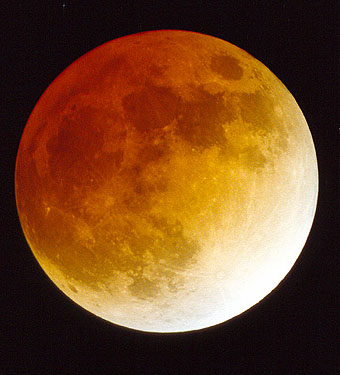Eclipse Preview

Explanation:
There are usually 1-2 lunar eclipses each year, and the nice thing
is that each one is visible from half the Earth. This image of the November 8, 2003
eclipse shows the Moon at maximum eclipse, but as you can see the lunar south polar
area was quite bright. This was because it was just barely a total eclipse - the
south pole of the Moon skimmed along the edge of the umbral (or darkest) shadow.
The October 27, 2004 (28th in Europe) eclipse should be darker because the Moon passes
well within the umbra. During totality on the 27th, the north pole will be the brighter
side because it will be closest to the edge of the umbra. Despite the fact that the
lunar orbit is very predictable, the color and darkness of eclipses are not. The
problem is that these hues depend upon the clarity of the Earth's atmosphere, but
of course that varies with time and place. The atmosphere can be full of debris (that
blocks sunlight and darkens eclipses) from forest fires, volcanic eruptions or even
recent meteor showers. For the October 27th eclipse none of these atmospheric perturbations
should be severe so a bright eclipse is expected. Visit the Sky & Telescope
web site to learn the Danjon Scale for eclipse brightnesses and then you can judge
how bright totality actually is. Clear skies!
